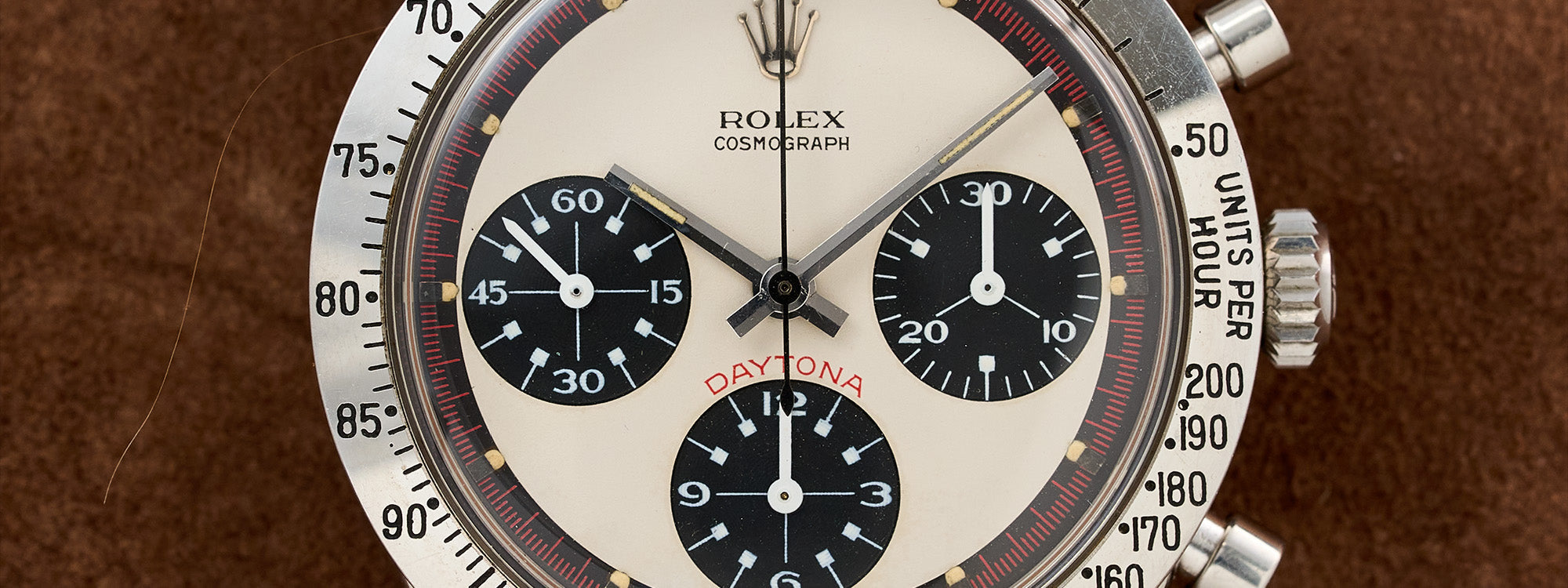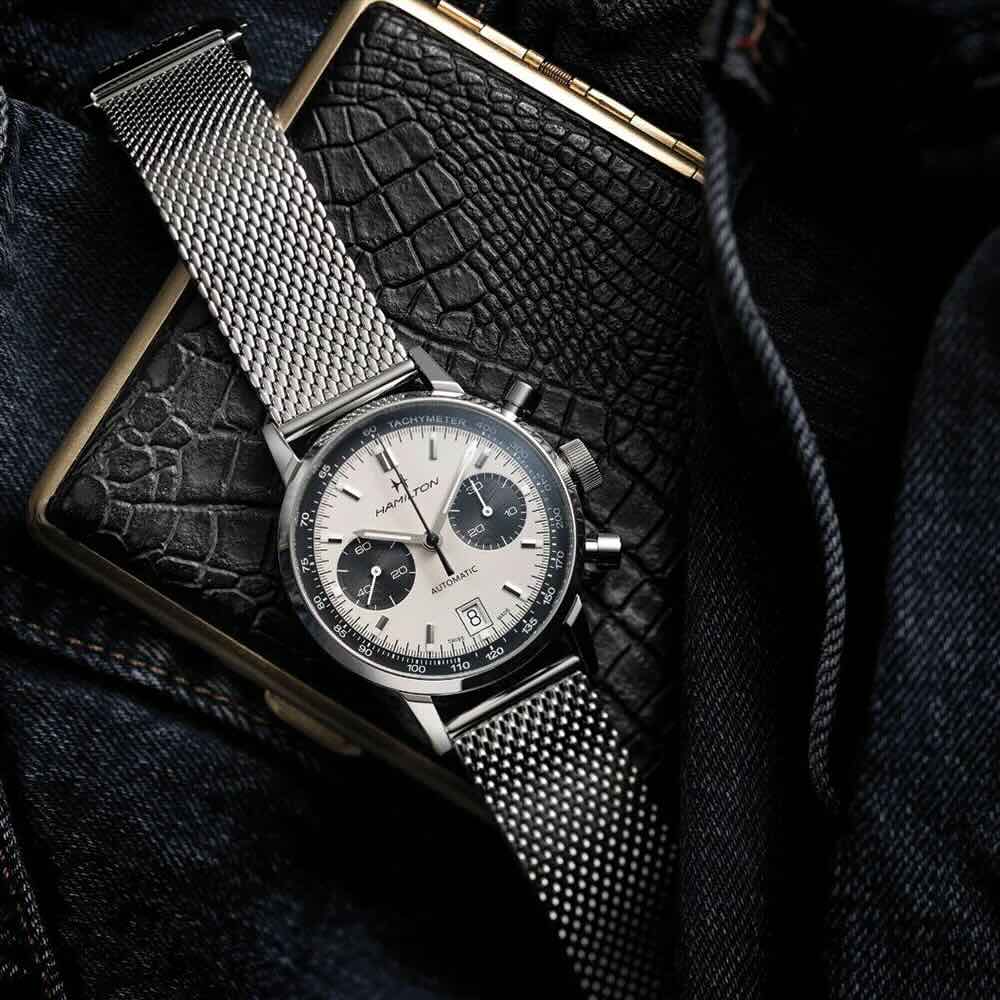If you are into watches and watch collecting, you have heard of the “Paul Newman Rolex,” have heard of it spoken of with reverence and awe, and have perhaps even longed to possess or at least see one yourself. But how did this watch — a very specific version of the Rolex Daytona — become the celebrity watch of all celebrity watches, as well as the né plus ultra representing the absolute highest echelon of watch connoisseurship? It’s a story of watch marketing savvy and market serendipity that spans the globe from Geneva to Daytona, from Cleveland to Hollywood.
Rolex was riding a hot streak of successes in the 1950s and early ‘60s. The Swiss company had already introduced to the market the definitive luxury divers’ watch, the Submariner; the quintessential luxury travel watch, the GMT-Master; and even an understated, rugged outdoor watch, the Explorer, that became a star in its one right by virtue of its role in the historic summit of Mount Everest. The one popular category that Rolex had yet to really crack was the emerging genre of motorsport-inspired wrist chronographs, an area in which brands like Heuer (today’s TAG Heuer), Longines, and Breitling had a substantial head start. Rolex boldly jumped into the fray, introducing its first “pre-Daytona” wristwatch chronograph, Ref. 6234, in 1955, and its successor, Ref. 6238, in 1962. Both were 36mm steel watches outfitted with manually wound Valjoux 72 calibers, and both had dials that read simply “Chronograph” rather than the now-familiar “Cosmograph” or “Daytona”; neither set the market on fire, a testament to their very low production run and extreme rarity today.

The pivotal partnership that launched the Rolex Daytona into the public consciousness was the Swiss watchmaker’s becoming the official timekeeper of the Daytona 500, the “Great American Race,” in 1962. In this new role, Rolex realized that a marketing connection to the popular race could jump-start public interest in its still-struggling lineup of chronograph watches. The following year, the Crown released the historic Ref. 6239, with the generic “Chronograph” on the dial now replaced by the more individualistic “Cosmograph” (a term that had been previously coined for the brand's long-discontinued moon-phase watches) and the tachymeter scale on the dial, a useful tool for racing drivers, moved to a more prominent spot on the bezel. The model — now regarded as the first “official” Daytona, though that name would not regularly appear on dials until later versions — also featured the two-tone dial arrangement, with contrasting main dial and subdial colors, that we now refer to in shorthand as “panda." The watch set the template for all versions of Rolex’s signature chronograph watch that would follow, but it wouldn’t really achieve its white-hot popularity and collectibility until several years later — after its distinctive look also caught the admiring eye of a Hollywood icon.
Rolex Meets Paul Newman
Paul Leonard Newman was born and raised in the suburbs of Cleveland, Ohio, and first showed an aptitude for acting at age 10, starring in a production of Saint George and the Dragon at the Cleveland Play House. After graduating high school and serving a brief stint in the U.S. Navy during World War II, Newman went to college to earn a BA in drama and economics, later attending the Yale School of Drama and studying under Lee Strasberg at the Actors Studio. Newman’s long and legendary professional career started in 1953, in a Broadway stage production of Picnic, and swiftly extended into television and eventually movie roles. His first breakthrough role, and first Academy Award nomination, came in 1958, co-starring with Elizabeth Taylor in Cat on a Hot Tin Roof. That accolade proved to be the first of many throughout the ensuing decades, in legendary films including The Long, Hot Summer (1958, with his future wife, Joanne Woodward), The Hustler (1961), Hud (1963), Hombre and Cool Hand Luke (both 1967).

The movie that proved to be the nexus between Paul Newman and the Rolex Daytona was 1969’s Winning, in which the actor portrayed a race car driver obsessed with winning the Daytona 500. To train for the role, Newman started attending Watkins Glen Racing School in upstate New York in the late 1960s. The movie itself was barely a footnote in Newman’s multiple award-winning career repertoire— even though it was a huge box-office hit at the time — but it sparked a competitive spirit that moved him to begin a second career as a racing driver and, later, a racing team owner. And Newman’s interest in motorsports was anything but a celebrity lark: he placed second in the 1979 24 Hours of Le Mans endurance race, among many other impressive accolades, and he raced competitively until 2006, when he was 81.
What is the Paul Newman Dial?
At the start of Newman’s racing career, his wife Joanne Woodward (she had also co-starred with him in Winning), gave him a gift that is today one of the most famous watches in the world: a Rolex Daytona Ref. 6239 with a so-called “exotic” dial, highlighted by some very particular details. Its main dial was an off-white cream color, punctuated by black subdials at 3, 6, and 9 o’clock with square-ended hashmarks and Art Deco-style numerals. Other aspects of the “exotic” Daytona dial include a crosshairs motif on the subdials, which appear in a contrasting hue from the main dial; an outer minute track also in a contrasting color to the main dial (black dial, white track and subdials, or vice versa, as in Newman’s watch); and a 15/30/45/60 configuration for the subdials rather than the more common 20/40/60. Hard as it may be to believe now, these dial versions were not that popular at the time, hence Rolex’s decision to limit their production.

Another rarity of the Ref. 6239: the word “Daytona,” which had begun appearing on some of the dials starting in 1965, appeared in red above the 6 o’clock subdial, an indicator that this reference was the first model that Rolex co-branded as a “Cosmograph Daytona” rather than simply a “Cosmograph” — the latter still being the more prominent name, appearing directly below the Rolex logo. On the back of the Daytona that she gave to her husband, Woodward had a loving but cautionary message personally engraved: “Drive Carefully - Me.”
Newman wore this watch, and two other similar Daytona models, also gifts from his wife, throughout his racing career. The Ref. 6239 model was manufactured somewhere between 1968- 1969 and was gifted in 1972. The second Daytona that Newman wore was a Ref. 6263, made in 1984, which has since been famously nicknamed the “Big Red” (more on which below). Woodward had this one personally engraved as well, with “Drive Carefully - Joanne.” The third and final Rolex Daytona spotted on Newman’s wrist — during the 2008 Indianapolis 500, just a few months before the actor’s death — was a white-gold Ref. 116519, and yes, it continued the theme of cautionary engravings on the caseback, with “Drive Very Slowly — Joanne.”

How that first Rolex Daytona, the now-legendary Ref. 6239, first drew the attention of an admiring public to become famous as the “Paul Newman Rolex” — a nickname it didn’t acquire until the 1980s, incidentally — is something of a mystery. Supposedly Newman’s Daytona began acquiring a fan base after he wore it on the cover of an Italian magazine in the 1970s, but no such cover has ever actually been found. Both Newman’s status as a big-screen icon and auto racing’s mainstream popularity as a spectator sport reached a zenith in the 1970s, and this confluence of events surely helped elevate the profile of the Rolex Daytona, as well as, to a lesser extent, other motorsport-inspired timepieces like TAG Heuer’s Monaco, worn by Steve McQueen in the 1971 racing film, Le Mans. Whatever lit the fuse, the Rolex Daytona exploded in popularity in the ensuing decades and remains one the most popular watches worldwide in the 21st Century. And the models known as “Paul Newman” Daytonas, while long out of production, continue to command eye-popping and even record-setting prices in the secondary market. Here is a breakdown of all of the vintage Rolex Daytonas considered part of the “Paul Newman” universe, and what makes each of them subtly unique.
Ref. 6239

The first-ever Rolex Daytona to be tagged with the “Paul Newman”moniker is the Ref. 6239 detailed above. It measured a very modest 36mm in stainless steel, with a stationary steel tachymeter bezel and — this is important to remember as we run through the following models — pump-style chronograph pushers at 2 and 4 o’clock rather than the screw-down pushers that would become standard on the Daytona. Also importantly, note the absence of the familiar verbiage “Oyster Perpetual” on the dial, a giveaway that Rolex did not use its hallmark waterproof Oyster case for these early Cosmographs and Daytonas, and also used a manually winding mechanical movement, either the Valjoux 72 or the Rolex-modified Valjoux 722. And whatever became of Paul Newman’s own Daytona 6239, the granddaddy of this entire collectors’ craze? In 2017, it became the most expensive Rolex watch ever sold at auction, fetching an earth-shaking $17.75 million at Phillips, a record sale yet to be matched by any other vintage Rolex watch.
Ref. 6240

Photo: Sotheby's
The technical and numerical evolution of the Daytona continued with the Ref. 6240 model in 1965, and its successor, the Ref. 6241, which came out the same year. The 6240 was notable as the first Daytona with screw-down chronograph pushers, an added feature to enhance the case’s water resistance. The 6240 thus became the first Daytona to bear the term “Oyster” in its dial. Also new on this reference was the use of black acrylic for the tachymeter bezel, superseding the steel bezel of the 6239. The über-collectible “Neanderthal” version of the 6240 is distinguished by its rare lack of indications on the dial: no “Cosmograph,” no “Daytona,” just the Rolex logo at 12 o’clock on the “exotic” panda-style dial. The elusive “Neanderthal,” which some experts speculate may have been a unique piece, sold at Phillips for $3.01 million in 2018.
Ref. 6241 and the John Player Special

Photo: Sotheby's
For whatever reason, Rolex went back to the pump-style, non-screwed pushers in the subsequent Ref. 6241, which many consider the true second evolution of the original Ref. 6239 “Paul Newman.” It differs from the former only in its larger case size (37.5mm) and in its key aesthetic evolution, the black acrylic tachymeter bezel that was ushered into the collection by the 6240. The 6241 version of the “Paul Newman” Daytona is even rarer than the 6239, commanding even higher prices today — especially in an iteration now famously known to collectors as the “John Player Special.” This variation of the “Paul Newman” Daytona evokes the black-and-gold livery of the John Player Formula 1 racing team — a color scheme derived from the packaging on the John Player & Sons cigarette brand of yesteryear — matching a gold case and Oyster bracelet to a black dial with contrasting golden subdials for the running seconds and chronograph displays. The reference was only produced until 1969, and of these models only about 300 are believed to have been made in this yellow-gold iteration, so they’re highly sought after on the collectors’ market. A “John Player Special” Ref. 6241 sold at Sotheby’s in Geneva for $2,491,655 in 2023, becoming the third most valuable Paul Newman Daytona in the world.
Ref. 6262

Photo: Bonhams
For the Daytona Ref. 6262, launched in 1970, Rolex brought back the solid steel bezel of the 6239 and also incorporated the non-screwed, pump pushers of the 6241. Inside was a new, upgraded movement, the Valjoux 727, which was still manually wound — Daytonas would not contain automatic movements until the first El Primero-equipped models in 1988 — but offered enhanced precision via a higher frequency of 21,600 vph. This particular combo of features did not set the market on fire at the time: Rolex produced the 6262 models for only one year, making the reference among the rarest, and of course making the smattering of “exotic” or “Paul Newman” dials in this series even rarer.
Ref. 6263 and Paul Newman’s “Big Red”

Another of the three Daytona models owned by Paul Newman himself, the Ref. 6263, first on the market in 1971, is one of the most collectible timepieces on the planet. Like the 6262 that preceded it the year before, this watch has a 37mm stainless steel case with a black acrylic tachymeter bezel, housing the Valjoux 727 caliber, but it also is equipped with the screwed-down chrono pushers established by the Ref. 6240 model several years earlier. (As it has been so often throughout its history, Rolex was a trendsetter in this area, as screw-down pushers wouldn’t be common in watches for decades to come.) Accordingly, these references bear the term “Oyster” on the dial. Interestingly, even by this point in their production, not all of these “Cosmograph” watches had a “Daytona” reference on their dials. However, the ones that did often placed it over the 6 o’clock subdial in red type, the emblematic feature of the so-called “Big Red” models that have become so hot on the auction circuit, perhaps because Newman’s own 6263 was a “Big Red.” Worth noting is that the watch owned by the Hollywood legend — which sold for $5,475,000 at Phillips’ “Racing Pulse” themed auction in 2020 — a wasn’t really a “Paul Newman Rolex” by definition, as it did not feature an “exotic” dial but a more conventional black dial with standard 20-60-40 subdials, sans the Art Deco details.
Ref. 6264 and the “Lemon” Paul Newman

Photo: Sotheby's
Launching alongside the Ref. 6262 Daytona in 1970, and remaining in production a bit longer, was the Ref. 6264, which had the same 37mm case and same Valjoux 727 movement but added the black acrylic tachymeter bezel of the previous 6240 and 6241 models. Still following? Like several of the earlier Daytona references, this one was available in yellow gold as well as steel, albeit in exceedingly small quantities. Two gold versions of this reference have become Holy Grails for collectors: one is the black-dialed “John Player Special” model, which follows the cues of the original Ref. 6241 version. The other is the so-called “Lemon” Paul Newman, which sports sort of the opposite color treatment as the John Player Special: a citrus-yellow main dial rather than a black one, with sleek, black subdials in the typical tricompax arrangement with the familiar “exotic” details. According to Sotheby’s, which auctioned one of them in 2022, only about a dozen of the “Lemon” dials are known to exist.
Ref. 6265

Photo: Phillips
The final Rolex Daytona model equipped with a manually wound Valjoux caliber before the ushering in of automatic movements with the El Primero era, the Ref. 6265 represents the end of an era, produced all the way up until 1987. It is a favorite of many collectors because of its clean, streamlined look, with a white-and-black “panda” dial with no red elements and the return of a sleek, solid steel bezel. The screw-down pushers have been retained, and the dial text, notably, consists of “Rolex Cosmograph Oyster,” with no “Daytona” in red or any other color, added above the 6 o’clock register. Like most Daytonas of the era, the model came primarily in steel, but the most expensive example of this reference ever sold was a “Unicorn” model in white gold ($5.937 million at Phillips in 2018, the second highest price ever paid for a Rolex at auction) whose provenance and authenticity has since come under scrutiny. The controversy is a reminder, if any is needed at this point, that one of the most popular and valuable watch models in the world is also one of most counterfeited. As always, caveat emptor, or as Newman himself is credited with saying, “if you’re playing a poker game and you look around the table and you can’t tell who the sucker is, it’s you.” You can learn more about the modern Daytona at rolex.com.























































0 Comments